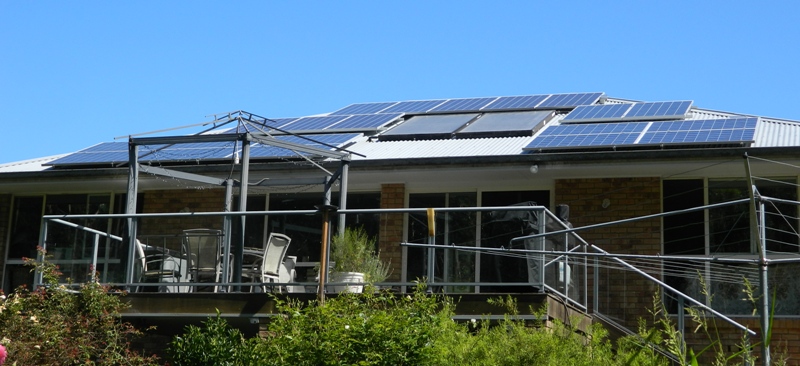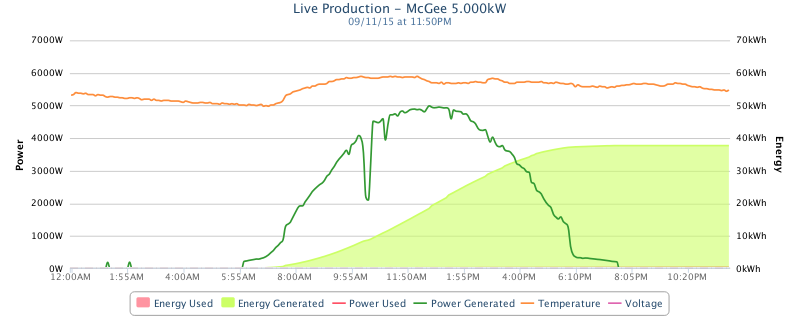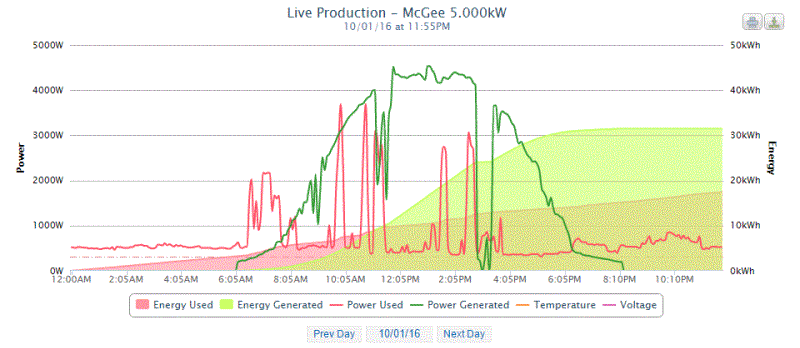Introduction
OK, OK, this isn't really
much of an innovation,. The combination of a flute making workshop
and rooftop solar power. But I had to find somewhere to put
it.
And maybe it isn't an innovation at all -
maybe the world is buzzing with flute makers already using solar power
to drive their workshops. But maybe that's not the point.
Maybe the point is that now we can! And, if we can, then perhaps
we should. So, humour me!
And the time is right to look
at this. The COP21 talks in Paris on saving the world from
calamitous climate change are just wrapping up as I type.
Hopefully they will end well and we can start turning our big ship
around, sailing for better weather.
(Update. The COP21
talks in Paris did go well, with universal agreement we will act on
reducing emissions. Now we wait to see how the world matches words
with action. I'm pretty confident. Anyway, back to our
story...)
Solar power in Australia
Solar power is increasingly
popular in Australia. We have about 9 million households, of which
1.4 million have rooftop solar (as of late 2015). That's nearly
16% of households. And for good reason -
we have sun, lots of sun. And mostly clear skies. And our
electricity prices are high, but the cost of photovoltaic systems is
dropping fast. Which is good, as we have the highest per-capita
output of CO2
emissions in the world! Abundant supplies of coal have left us
lazy.
Making solar power work
Now if you've ever looked
into the viability of rooftop solar, you'll have spotted the catch.
The electricity companies are happy to accept your energy contribution
to the grid, but less happy to pay for it. In our area it works
out like this. 1KWHr of energy from the grid costs about 22cents.
The same amount of power fed into the grid earns just 6 cents. The
companies can mount any number of arguments in support of that 360%
imbalance. We can mount a similar number in opposition. But
unfortunately, they win. For the moment....
So the take-home message from
all that is that it's much better if you can use the energy you
generate, rather than let it go into the grid. And that's often a
problem for most workers. While the sun is shining, they are away
at work. You might be able to program the dishwasher to kick in at
10:00, and the washing machine to kick in at 11:00, but how to use the
rest of the day's incoming energy productively?
But the flutemaker is in a
different position. You're at home during the day, cranking out
flutes. Hey, this has possibilities....
How much energy?
So how big a system would we need? Let's look at
the big machines. The circular saw, used to cut up blanks, 2HP.
The big metal lathe, used for reaming and other heavy tasks, also 2HP.
Woodlathe, used for faster work, 1.5HP. Big bandsaw, ditto.
Mill, used for drilling and slotting, 2HP. Compressor, 2HP. Drill press, 1.5HP.
Because I mostly work alone, only one gets used at a time. We pick the
larger, 2HP, or in modern language, 1.5KW. But wait!
While the big machine is running, so is the dust extractor, also 2HP, or
1.5KW. And maybe 1KW of lighting. So that's adding up to 4KW
power demand. Ah, but wait again. While all that's
happening, I might be running the CNC lathe and its computer, controller
and dust extractor, which would take us over 6KW if all fully loaded at
the same time. OK, short
answer, as much power as we can get!
Will that fit?
So that brings us to what's feasible, both physically
and financially. And that brings us to examine the physical
constraints. The back of our house faces almost exactly north,
within half a degree. And in the southern hemisphere it's the
northern roof we want. But we also have forest on that side, and our
eucalypt forests are something to behold. The trees rise 40 metres
(131 ft) from the forest floor. Fortunately, the nearest are far
enough away that we have no shading problem for most of the year.
But for the month or so each side of the winter solstice, the lower part
of the northern roof does suffer some shading. And that made us
reach for a special solution. A problem with a single
string of solar panels is that if any of them are shaded, it reduces the
efficiency of the entire string. So we went with a two-sting
inverter. The panels at the top of the roof form one string, those
at the bottom the second. If the forest shades the lower panels,
the upper panels will keep cranking out power. That's a
slightly unusual application of a two-string inverter. They are
mostly used when panels have to be split over two sides of a roof, eg
half to the north east, half to the north west. But it works to
our advantage here. So, what we could use and what would
fit led us to a specification. We should be able to fit a total of
twenty 250W panels, which neatly breaks into two strings of total 5KW.
Installation day
Installation day arrived, and we faced it confidently.
We'd come up with the plan to use the two-string inverter for the upper
and lower set of panels on the roof, and the installation company had
agreed to that. But, when boots hit roof, a complication
arose. Although there was room for the lower string to go along
the bottom edge of the roof, there was only one accessible row of
roofing screws. The installers make use of the existing roofing
screws on corrugated iron roofs, and they need access to two rows.
The installers said, don't worry, we'll put the second string on the
western roof - you only lose about 10% of energy. That might be
all very fine on open flat land, but we have a massive forested hill to our
west, and that would knock out a few hours of sunlight. So no go!
Everybody put their thinking caps on, and we struggled to come up with a
viable solution. Finally it was the installers who hit jackpot.
Split the intended bottom row of 10 panels in portrait mode into two
banks of 6 and 4 panels in landscape mode and they could find enough
screws to secure it all. The upper string had to be split
too, but into one row of 5 panels, and a second row of 3 and 2 panels,
all in portrait mode, in order to get around our solar hot water
service. Looks a bit messy, but the only people who can see it are
the wallabies who live in our forest.

Now it's not easy to get an image of your roof, so please excuse the
rather cluttered image above. The odd hexagonal frame at left is
not an antenna for communicating with extraterrestrials (that's around
the other side of the house), just the frame of a gazebo we put up in
summer to shade our outdoor eating area. The two grey panels in
the centre of the roof are solar hot water panels which also work
fabulously to keep our hot water costs to a minimum. The other
(blue) panels are the new solar array. You can also see a
small extract of the wide blue skies we have down here. What the
residents of Beijing would pay for a chunk of that over their house!
Ignition
The day before the panels were installed, a registered
electrician had come to install the new bi-directional power meter, so
once the solar panels and the inverter had been installed and wired, we
were ready to go. And go it did, generating over 4KW at midday
even though it was early spring and the sun was still relatively low on
the horizon. At the time of writing (late spring - December),
we often see it top the theoretical 5KW maximum.
Monitoring
As a fully-diagnosed and registered data freak, I need
to know what amount of energy we are generating and what we are using,
so I've installed a Current Cost metering system to keep track of that.
Data is captured every 5 minutes or so, and automatically sent to a pair
of monitoring sites on the web, which return it nicely graphed for your
edification. It confirms that on a good day we can expect to
generate more than 35KWHrs of energy (light green shaded section of
graph). The thin green line shows the actual power generated at
any time throughout the day. You can see how that fits in nicely
with the working day.

I believe you can monitor the output of our system from the
convenience of your own device (how weird is that!).
Try it:
McGee
5000W
At the time of writing, I can't take full advantage of all the system
can show, as I'm waiting on delivery of the Gateway needed to send
multiple channels of data. I'll update the graph when that
happens.
Update!
And it has happened. My new Gateway arrives, and after a few
hassles, we get the data collection going. As you can see, the
image below is similar to the image above, except we now have two
power-related traces:
-
The thin green trace is power generated. It
follows the usual pattern of rising in the morning, peaking around
noon and fading in the afternoon that we saw above, except on the
day there were some periods of heavy cloud.
-
The thin red trace is monitoring the energy consumed
in the house and workshop.

The burst of consumption starting around 6:30am was the breakfast rush,
unfortunately outside of generation time, but we're not going to be
ruled by this monster! Jesse also absentmindedly ran the washing
machine, rather than waiting for more sunlight. We're still
getting used to this!
But the five big spikes later in the day were me in the workshop, boring
flute blanks. And that was the perfect job to test the system.
To bore flutes, I use a gun-drill mounted on the metal lathe carriage.
This means that the 2HP lathe motor is not only rotating the blank, but
also power-driving the carriage towards the chuck, advancing the
gun-drill through the work. It's all done at the highest speed
available, and at a fast feed. That's pretty demanding, and you
can hear the motor slow a semitone as the drill engages the hard
end-grain of the very hard wood.
But as well as that, the 2HP compressor is in use, pumping compressed
air through the gun drill to clear cuttings out, to prevent the drill
from binding. And of course that means we would be spraying dust
and granules everywhere, if it were not for the 2HP dust extractor
sucking it all up.
So that's a total of 6HP, or 4.5KW of potential demand. Perhaps
5KW with lighting. And we can see on the red trace that I did 5
bursts of gun-drilling spread throughout the day to give man and
machines a rest. Plus a few other jobs around the workshop, but as
you can see, they didn't use that much power. The small peak just
before 4:00pm also involved the metal lathe, but not the other two
machines. And the job was undemanding - just turning a small piece
of Delrin for a thumb-rest.
We can see that even this highest level of power demand generally came
within the generation envelope (the green trace). But clearly, one
should only gun-drill when the sun shines best.
We can also learn something from the pink and green shaded areas of the
chart. They show the total energy (in KW-Hours) that we consumed
(pink) and generated (light green) integrated over the day. You
can see we generated 32KWH, used 18, and thus contributed 14KWH to the
grid, a net boon to humankind. We can have our cake and eat it
too!
Cost and returns
So, what did it end up costing? About $7500AUD, or
USD $5300. Or in "Irish music international exchange units", about
1.6 six-keyed flutes. That's not really a lot, is it.
It's obviously going to take about a year to know what impact it's had
on our electricity costs. One reason for that is that we need to
see the full set of seasons, but I've done some modelling on results so
far, and it's looking promising. It looks like it should halve our
domestic electricity bill and that represents a return on investment of
about 12%. That means it should pay itself off in about 8.4 years.
Since the system should operate for 25 years or so, that should keep us
in low-price electricity till some new technology replaces it.
But, whatever the financial impact, it's nice to know we are generating
more energy than we are using. And perfectly clean energy at that.
In these climatically-challenged times, that's priceless.
Ah, now the sun has come out, so it's time for me to get down there and
make some solar powered flutes! |